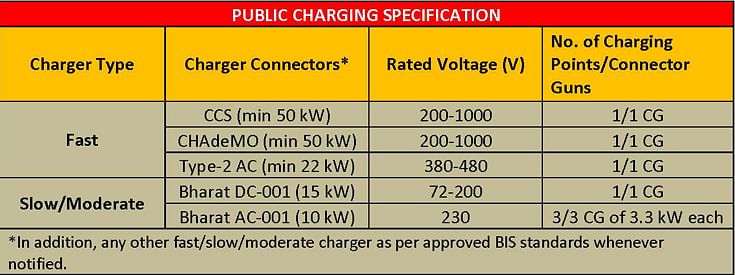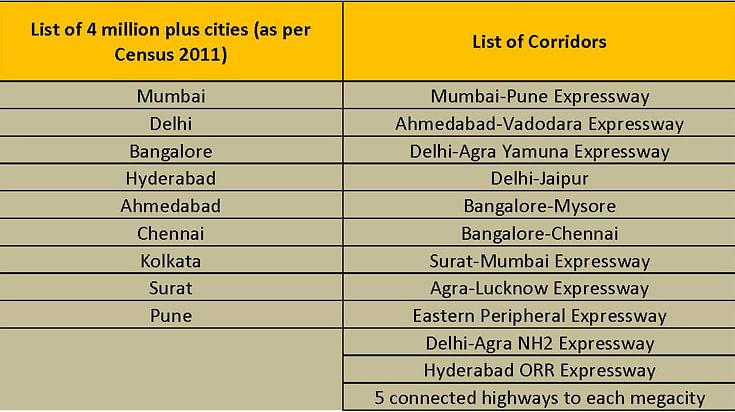Centre issues EV charger guidelines, existing EV users won't be able to use fast charge
With the specification for fast charging including CCS, CHAdeMO and Type-2 AC being between 200 to 1,000 V, EVs commercially sold in India cannot use the high power output as they are in the range of less than 100V.
In a much-needed push for adoption of electric vehicles (EVs), the Ministry of Power has issued the guidelines and standards for the EV charging infrastructure in India. In what has been seen as a chicken-and-egg situation, the clarity on EV charging standards may provide some respite to companies keen to plug into the EV charging business.
The government says the objective of this move will enable faster adoption of EVs in India by facilitating a safe, reliable, accessible and affordable charging infrastructure and eco-system. As per the government guidelines, accessed by Autocar Professional, power distribution companies can facilitate setting up private charging at residences and offices.
Setting up of public charging stations will not require any licence as long as it meets the technical and performance standards and the protocols laid down by the Ministry of Power and Central Electricity Authority. In fact, for setting up a public charging station, the distribution company will provide proper connectivity on priority. The charging infrastructure can obtain electricity from any generation company through open access.
Existing EV owners could miss out on fast charging
While the government's specification for fast charging includes CCS, CHAdeMO and Type-2 AC with Rated Voltage (V) being in the range of 200 to 1,000 V, interestingly, as per an EV industry expert, none of the EVs commercially sold in India till date can utilise the high power output as EVs in India are in the range of less than 100V.

To briefly put it, the fast-charging capabilities are future-ready but cannot be utilised by initial adopters of EVs in India unless there is some kind of alteration / tweaking done to them so that they are able to utilise the higher power input.
The guidelines further propose setting up of at least one charging station in a grid of 3km x 3km, and another one on both sides of highways/roads at every 25km. In case of 'long-distance EVs and/or heavy duty EVs like trucks/buses,' a fast-charging station is proposed at every 100km, one on each side of the highway/road. In fact, the government has said that existing retail outlets of oil marketing companies (OMCs) will be given higher preference for setting up public charging stations, complying with all safety norms.
In terms of cost for the supply of electricity to the public charging stations, the government says the pricing will be determined by the appropriate commission, provided 'that the tariff shall not exceed the average cost of supply plus 15 percent.'
Mumbai, Delhi, Bangalore in Phase 1 of rollout
In terms of the scheme rollout, a total of nine cities are shortlisted for Phase 1 (1-3 years) with a population of over 4 million as per Census 2011. All existing expressways connected to these cities and important highways connected with each of these will also be covered in the first phase.
The second phase, which will begin by 2021, will target tier-1 cities. Union Territory headquarters shall be covered for distribution and demonstration purpose.
Battery swapping
Battery swapping also finds mention. The government guidelines have laid down requirement for public charging infrastructure to have appropriate 'Climate Control Equipment' for fast charging of batteries to be used for swapping, which would effectively mean that the government is looking at all possible ways to promote the EV megatrend.
However, the bigger challenge for battery swapping in India would mean that all EV OEMs would need to not only adopt and accept the same size of battery but also the chemistry, failing which the battery swapping technology would lead to a disastrous result for the end-user. For instance, an EV with certain battery chemistry being swapped with one having a different chemical composition.

RELATED ARTICLES
VinFast’s second plant in Vietnam goes on stream ahead of India factory
Vietnamese EV maker’s second plant in its home market, which has a 200,000 EVs-per-annum capacity, will focus on produci...
Continental exits TBR market in India, shifts focus to car and SUV radials
German tyre manufacturer aims to tap the double-digit market growth opportunity for big SUV and luxury car tyres which w...
New ZF SELECT e-drive platform gives EV makers a choice in 100 to 300 kW range
Modular e-drive platform optimally matches 800-volt overall system and components such as the electric motor and power e...





 17 Dec 2018
17 Dec 2018
 8503 Views
8503 Views





 Autocar Professional Bureau
Autocar Professional Bureau




